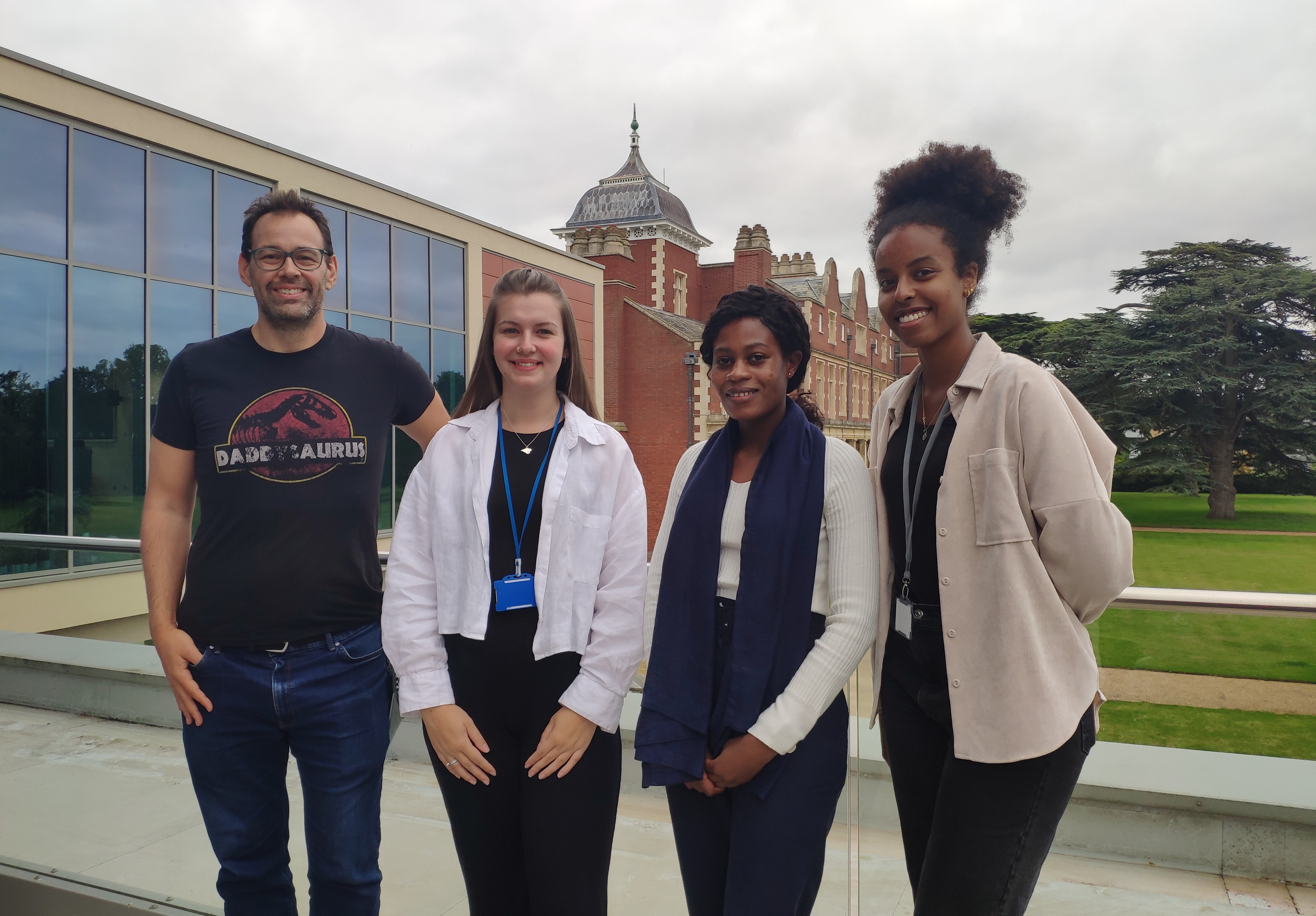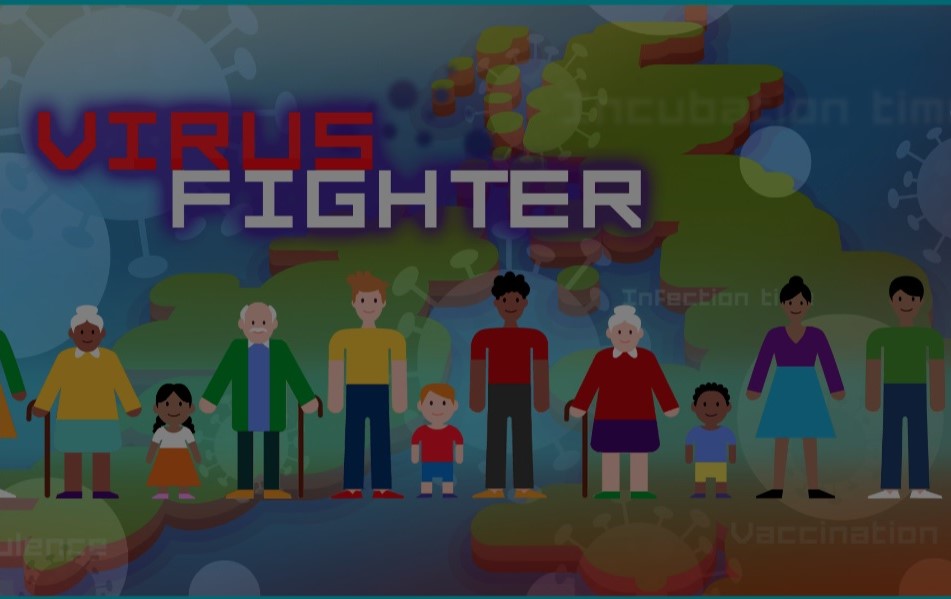Public Engagement award for the VirusFighter team
 Wednesday, December 1, 2021 at 9:58AM
Wednesday, December 1, 2021 at 9:58AM Congratulations to the VirusFighter team for winning the Babraham Institute Public Engagement Award! VirusFighter is the reincarnation of VirusBreak. Over the last year I've worked with the PhD students in our lab, Amy Dashwood, Ntombizodwa Makuyana and Magda Ali, together with lab alumni David Posner, to create missions for VirusFighter - allowing the player to be Prime Minister of the UK during different virus outbreaks. GameDoctor created the interface, with liason via the PE team here at the Babraham Institute.
Congrats to Amy, Tombi, Magda and David - a huge contribution to scientific communication, and all during the first year of their PhDs!

VirusFighter
 Monday, November 29, 2021 at 10:56AM
Monday, November 29, 2021 at 10:56AM I'm very excited to announce the release of our new game, VirusFigher!
VirusFighter simulates the outbreak of viruses in the UK. Try the free play mode, and learn how small tweaks to viral lethality, virulence or incubation time change the dynamics of an outbreak. Test whether quarantine, social distancing or vaccination is the best approach for different viruses, and track the lives lost, the burden to the NHS and the economic cost.
Or perhaps try mission mode: how would you do as Prime Minister during an outbreak of flu or COVID? Think you could do better? Listen to the advice of an immunologist at each critical decision point, and see how many lives your decisions cost. It is not always easy - see what the economist says and keep an eye on the economic cost too! When you've got that down pat, give a shot at something more exotic - an Ebola outbreak, or the "Big One" that gives virologists nightmares - Ebola gone airborne. Don't get too cocky with your good results managing COVID though, different outbreaks are best managed with different strategies.
VirusFighter is a neat tool for understanding how viruses spread and can be contained, for adults and children alike. Thanks to Simon Andrews for generating the original VirusBreak engine, GameDoctor for the new game engine behind VirusFighter, the Babraham PE team, and the science team: Amy Dashwood, Ntombizodwa Makuyana, Magda Ali and David Posner.
Children’s book brings our immune system to life
 Tuesday, October 19, 2021 at 8:38AM
Tuesday, October 19, 2021 at 8:38AM - ‘Maya’s Marvellous Medicine’, the third children’s book by immunologist Prof. Adrian Liston and illustrated by artist Dr Sonia Agüera-Gonzalez launches today.
- The book sees Maya learn about the cells that make up our immune system and how vaccinations prepare these cells for battle.
- The book is available to read for free online, or purchase as a physical copy.
Professor Adrian Liston, Senior Group Leader at the Babraham Institute, and artist Dr Sonia Agüera-Gonzalez have published a captivating story book to teach children about the immune system and why vaccinations are important. As some children begin to receive the flu vaccine ahead of this winter and with pharmaceutical companies applying for approval of their COVID-19 vaccines for children under 12, ‘Maya’s Marvellous Medicine’ can be used by adults to discuss key scientific concepts with them. The book is available on Issuu and Amazon today.
The book is set in a doctor’s office just before Maya receives a vaccination. Maya learns that vaccines are made up of bits of microbes that your body practices fighting, just like Maya practiced for her race at school. The doctor explains to Maya that dendritic cells present B and T cells with the clues that allow them to defeat the real microbes, even if that is years later.

The message in Prof. Liston’s book is two-fold, he explains: “After reading ‘Maya’s Marvellous Medicine’ I hope that kids will understand what a vaccine is, and how the immune system practices. More important, though, is the underlying message of empathy. Vaccines protect you, but they also protect your loved ones and your community.” Protecting others is the focus of Prof. Liston’s first book ‘Battle Robots of the Blood’, about a boy with a compromised immune system.
As an immunologist, Prof. Liston hopes his book sparks an appreciation for vaccines and work like his: “I'd love kids to learn just how cool the immune system is, and parents to be reminded that vaccines make us all safe. Vaccines have likely saved more lives than all other medical interventions combined, and yet they've come under targeted attack over the past decade, with deliberate misinformation campaigns. That means we need to be creating positive proactive stories, like Maya's Marvellous Medicine or Battle Robots of the Blood.”

Talking about her experience working on this series of books Dr Sonia Agüera-Gonzalez commented: “I have thoroughly enjoyed bringing Maya to life and telling such an important story. Books like the ones we have made can be a powerful tool for teachers, educators, parents and carers who would like to have conversations with young children about vaccines without glossing over the science behind the jab.”
Prof. Liston added: “I always look forward to seeing the new styles of illustration Sonia brings to a project. I also love seeing my own son’s reaction to the final products. This book is dedicated to him for all the time we spent together in the lockdown.”
 science communication
science communication Maya's Marvellous Medicine
 Monday, October 18, 2021 at 11:34AM
Monday, October 18, 2021 at 11:34AM  Our latest book for children, "Maya's Marvellous Medicine", is now out!
Our latest book for children, "Maya's Marvellous Medicine", is now out!
Follow Maya as she learns all about vaccines - the most marvellous medicines. Maya learns how the immune system works, and how vaccines help the immune system to be strong. Whether it is the immune system or a running race, the lesson is clear - practise makes perfect!
Take a look, either to learn all about vaccines and the immune system, or simply to enjoy the gorgeous illustrations by Tenmei.
The book is available freely in a digital format at Issuu, or you can order a paperback copy at Amazon.
Spreek je Nederlands? Met dank aan Erika Van Nieuwenhove, lees "Maya's magnifiek medicijn" op Issuu of Amazon.
Congratulations to Ntombizodwa Makuyana
 Saturday, October 9, 2021 at 3:59PM
Saturday, October 9, 2021 at 3:59PM  Congratulations to Ntombizodwa Makuyana, for winning the Babraham Institute prize for best poster by a first year PhD student!
Congratulations to Ntombizodwa Makuyana, for winning the Babraham Institute prize for best poster by a first year PhD student!
A great start to a high potential PhD!
New understanding of cell stability with potential to improve immune cell therapies
 Saturday, July 24, 2021 at 10:31PM
Saturday, July 24, 2021 at 10:31PM 
Researchers identify the origin of potentially dangerous unstable cells
Key points:
- Researchers have identified the origin of unstable cells, with potential to improve the safety of immune cell therapies.
- When using immune cells to treat disease, there is a risk that the cells switch from protective to destructive behaviour.
- Studies in mice have allowed researchers to identify the cells most at risk of becoming harmful.
By purifying cells using markers of instability, or following a two-step purification process, the researchers are able to produce a robust set of protective cells. Research in mice, published today by researchers at the Babraham Institute, UK and VIB-KU Leuven, Belgium, provides two solutions with potential to overcome a key clinical limitation of immune cell therapies. Cell therapy is based on purifying cells from a patient, growing them up in cell culture to improve their properties, and then reinfusing them into the patient. Professor Adrian Liston, Immunology group leader at the Babraham Institute, explained: “The leading use of cell therapy is to improve T cells so that they can attack and kill a patient’s cancer, however the incredible versatility of the immune system means that, in principle, we could treat almost any immune disorder with the right cell type. Regulatory T cells are particularly promising, with their ability to shut down autoimmune disease, inflammatory disease and transplantation rejection. A key limitation in their clinical use, however, comes from the instability of regulatory T cells – we just can’t use them in cell therapy until we make ensure that they stay protective”. By identifying the unstable regulatory T cells, and understanding how they can be purged from a cell population, the authors highlight a path forward for regulatory T cell transfer therapy. The study is published today in Science Immunology.
 T cells come in a large variety of types, each with unique functions in our immune system. “While most T cells are inflammatory, ready to attack pathogens or infected cells, regulatory T cells are potent anti-inflammatory mediators”, Professor Susan Schlenner, University of Leuven, explains. “Unfortunately this cell type is not entirely stable, and sometimes regulatory T cells convert into inflammatory cells, called effector T cells. Crucially, the converted cells inherit both inflammatory behaviour and the ability to identify our own cells, and so pose a significant risk of damage to the system they are meant to protect.”
T cells come in a large variety of types, each with unique functions in our immune system. “While most T cells are inflammatory, ready to attack pathogens or infected cells, regulatory T cells are potent anti-inflammatory mediators”, Professor Susan Schlenner, University of Leuven, explains. “Unfortunately this cell type is not entirely stable, and sometimes regulatory T cells convert into inflammatory cells, called effector T cells. Crucially, the converted cells inherit both inflammatory behaviour and the ability to identify our own cells, and so pose a significant risk of damage to the system they are meant to protect.”
The first key finding of this research shows that once regulatory T cells switch to becoming inflammatory, they are resistant to returning to their useful former state. Therefore, scientists need to find a way to remove the risky cells from any therapeutic cell populations, leaving behind the stable regulatory T cells. By comparing stable and unstable cells the researchers identified molecular markers that indicate which cells are at risk of switching from regulatory to inflammatory. These markers can be used to purify cell populations before they are used as a treatment.

In addition to this method of cell purification, the researchers found that exposing regulatory T cells to a destabilising environment purges the unstable cells from the mixture. Under these conditions, the unstable cells are triggered to convert into inflammatory cells, allowing the researchers to purify the stable cells that are left. “The work needs to be translated into human cell therapies, but it suggests that we might be best off treating the cells mean”, says Professor Adrian Liston. “Currently, cell culture conditions for cell therapy aim to keep all the cells in optimal conditions, which may actually be masking the unstable cells. By treating the cultures rougher, we may be able to identify and eliminate the unstable cells and create a safer mix of cells for therapeutic transfer”. Dr Steffie Junius, lead author on the paper, commented: “The next stage in the research is to take the lessons learned in mice and translate them into optimal protocols for patients. I hope that our research contributes to the improved design and allows the development of effective regulatory T cell therapy."
Establishing a thorough process to improve cell population stability in mice helps to lay the groundwork for improved immune cell therapies in humans, although the methods described in this work would require validation in humans before they were used in cell therapy trials. Tim Newton, CEO of Reflection Therapeutics, a Babraham Research Campus-based company designing cell therapies against neuro-inflammation and independent from the research, commented on the translational potential of the study: "This research makes a significant impact on regulatory T cell therapeutic development by characterising unstable subsets of regulatory T cells that are likely to lose their desirable therapeutic qualities and become pro-inflammatory. The successful identification of these cells is of great importance when designing manufacturing strategies required to turn potential T cell therapeutics into practical treatments for patients of a wide range of inflammatory disorders."
Read the full paper here.
 Liston lab,
Liston lab,  immunology
immunology 





